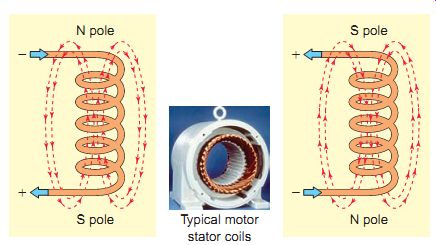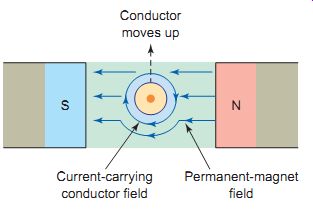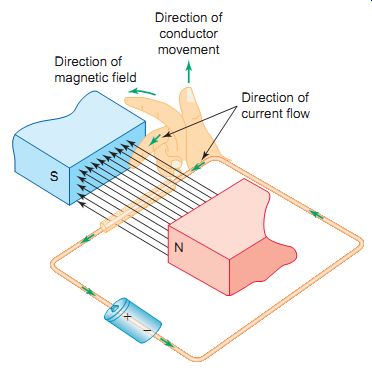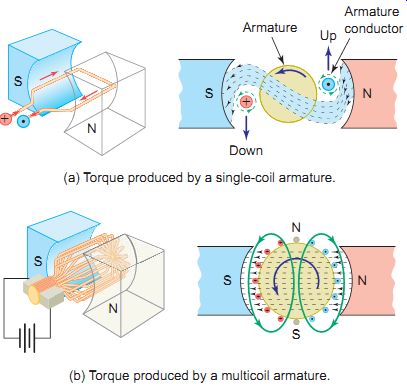AMAZON multi-meters discounts AMAZON oscilloscope discounts
Electric Motors
Introduction
GOALS:
1. Understand the basic electric motor operating principle.
2. Have a working knowledge of the construction, connection, and operating characteristics of different types of DC motors.
3. Have a working knowledge of the construction, connection, and operating characteristics of different types of AC motors.
4. Carry out testing procedures used to troubleshoot motor problems.
An electric motor converts electric energy to mechanical energy by using interacting magnetic fields. Electric motors are used for a wide variety of residential, commercial, and industrial operations. This section deals with the operating principles of different types of DC, universal, and AC electric motors.
PART 1: Motor Principle
Magnetism
Electric motors are used to convert electric energy into mechanical energy. The motor rep resents one of the most useful and labor-saving inventions in the electrical industry. Over 50 % of the electricity produced in the United States is used to power motors.
An electric motor uses magnetism and electric currents to operate. There are two basic categories of motors, AC and DC. Both use the same fundamental parts but with variations to allow them to operate using two different kinds of electrical power supply.
Magnetism is the force that creates rotation for a motor to operate. Therefore, before we discuss basic motor operation, a short review of magnetism is in order. Recall that a permanent magnet will attract and hold magnetic materials such as iron and steel when such objects are near or in contact with the magnet. The permanent magnet is able to do this because of its inherent magnetic force, which is referred to as a magnetic field. In Ill. 1, the magnetic field of a permanent bar magnet is represented by lines of flux. These lines of flux help us to visualize the magnetic field of any magnet even though they actually represent an invisible phenomenon. The number of flux lines varies from one magnetic field to another, and the stronger the magnetic field, the greater the number of lines of flux. Lines of flux are assumed to have a direction of movement from an N pole to an S pole of a magnet as shown in the diagram.
Electromagnetism
A similar type of magnetic field is produced around a current-carrying conductor. The strength of the magnetic field is directly proportional to the amount of current flowing through the conductor and takes the form of concentric circles around the wire. Ill. 2 illustrates the magnetic field around a straight current-carrying conductor. A relationship exists between the direction of current flow through a conductor and the direction of the magnetic field created. Known as the left-hand conductor rule, it uses electron flow from negative to positive as the basis for the current direction.
When you place your left hand so that your thumb points in the direction of the electron flow, your curled fingers point in the direction of the lines of flux that circle the conductor.
When a current-carrying conductor is shaped into a coil, the individual flux lines produced by each of the turns form one stronger magnetic field. The magnetic field produced by a current-carrying coil resembles that of a permanent magnet. As with the permanent magnet, these flux lines leave the north of the coil and reenter the coil at its south pole. The magnetic field of a wire coil is much greater than the magnetic field around the wire before it’s formed into a coil and can be further strengthened by placing a core of iron in the center of the coil. The iron core presents less resistance to the lines of flux than the air, thereby causing the field strength to increase. This is exactly how a motor stator coil is constructed: using a coil of wire with an iron core. The polarity of the poles of a coil reverses whenever the current flow through the coil reverses. Without this phenomenon, the operation of electric motors would not be possible.

Ill. 1 Magnetic field of a permanent bar magnet. Lines of flux

Ill. 2 Magnetic field around a straight current- carrying conductor.
Direction of electron flow; Direction of lines of flux

Ill. 3 Magnetic field produced by a current-carrying coil. Typical motor
stator coils.

Ill. 4 Motor principle. N S. Attraction; Rotation; N S; Stator; Repulsion;
Rotation; Armature

Ill. 5 A current-carrying conductor, placed in a magnetic field. SN;
Current-carrying conductor field; Permanent-magnet field; Conductor moves
up

Ill. 6 Right-hand motor rule. Direction of conductor movement; Direction
of current flow; Direction of magnetic field

Ill. 7 Developing motor torque. (a) Torque produced by a single-coil
armature. Armature conductor; Armature; Up; (b) Torque produced by a multi-coil
armature.
Motor Rotation
An electric motor rotates as the result of the interaction of two magnetic fields. One of the well-known laws of magnetism is that "like" poles (N-N or S-S) repel while "unlike" poles (N-S) attract. Ill. 4 illustrates how this attraction and repulsion of magnetic poles can be used to produce a rotating force. The operation can be summarized as follows.
• The electromagnet is the moving armature part and the permanent magnet the fixed stator part.
• Like magnetic poles repel each other, causing the armature to begin to turn.
• After it turns part way around, the force of attraction between the unlike poles becomes strong enough to keep the permanent magnet rotating.
• The rotating electromagnet continues to turn until the unlike poles are lined up. At this point the rotor would normally stop because of the attraction between the unlike poles.
• Commutation is the process of reversing armature current at the moment when unlike poles of the armature and field are facing each other, thereby reversing the polarity of the armature field.
• Like poles of the armature and field then repel each other, causing armature rotation to continue.
When a current-carrying conductor is placed in a magnetic field, there is an interaction between the magnetic field produced by the current and the permanent field, which leads to a force being experienced by the conductor. The magnitude of the force on the conductor will be directly proportional to the current which it carries. A current-carrying conductor, placed in a magnetic field and at right angles to it tends to move at right angles to the field.
==
DC motors:
- Permanent magnet
- Series wound
- Shunt wound
- Compound wound
- Universal Single phase
- Induction Wound rotor; Squirrel cage
- Split phase
- Capacitor start
- Permanent split capacitor
- Capacitor start/capacitor run
- Split-phase start/capacitor run
- Shaded pole
- Repulsion; Repulsion start; Repulsion induction
- Synchronous; Synchronous Induction
- Squirrel cage
- Wound rotor
- Hysteresis
- Reluctance
- Permanent magnet
- Polyphase AC motors

Ill. 8 Family tree of common motors.
==
A simple method used to determine the direction of movement of a conductor carrying current in a magnetic field is the right-hand motor rule. To apply this rule the thumb and first two fingers of the right hand are arranged to be at right angles to each other with the forefinger pointing in the direction of the magnetic lines of force of the field, the middle finger pointing in the direction of electron current flow (- to +) in the conductor. The thumb will then be pointing in the direction of movement of the conductor. Applying the right-hand motor rule to Ill. 6, the conductor will move upward through the magnetic field. If the current through the conductor were to be reversed, the conductor would move downward.
Note that the conductor current is at a right angle to the magnetic field. This is required to bring about motion because no force is felt by a conductor if the current and the field direction are parallel.
Ill. 7a illustrates how motor torque (rotational force) is produced by a current-carrying coil or loop of wire placed in a magnetic field. Rotation is the result of the interaction of the magnetic fields generated by the permanent magnets and current flow through the armature coil.
This interaction of the two magnetic fields causes a bending of the lines of force. When the lines tend to straighten out, they cause the loop to undergo a rotating motion. The left conductor is forced downward, and the right conductor is forced upward, causing a counterclockwise rotation of the armature. A practical motor armature is made up of many coils of conductors.
The magnetic fields of these conductors combine to form a resultant armature field with north and south poles that interact with those of the main stator field to exert a continuous torque on the armature.
In general, motors are classified according to the type of power used (AC or DC) and the motor's principle of operation. There are several major classifications of the motors in common use; each will specify characteristics that suit it to particular applications. Ill. 8 shows a family tree of common types of motors.
QUIZ:
1. What is the basic purpose of an electric motor?
2. In general, in what two ways are motors classified?
3. In what direction are the lines of flux of a magnet assumed to travel?
4. How does electricity produce magnetism?
5. Why is the motor stator coil constructed with an iron core?
6. How is the polarity of the poles of a given coil reversed?
7. In general, what causes an electric motor to rotate?
8. In what direction will a current-carrying conductor, placed in and at right angles to a magnetic field, move?
9. Applying the right-hand motor rule to given current-carrying conductor placed in a magnetic field indicates movement in the downward direction. What could be done to reverse the direction in which the conductor moves?
10. What two main criteria are used to classify motors?
Cont. to part 2